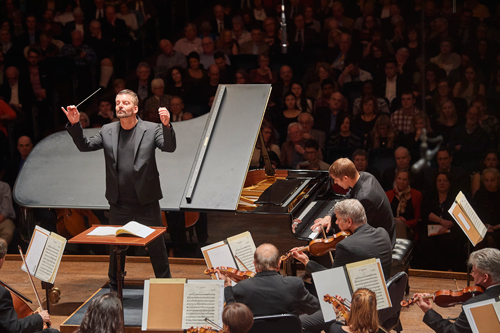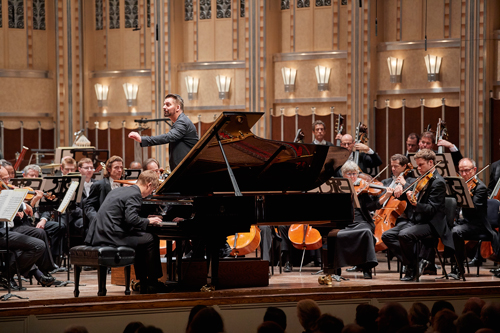by Daniel Hathaway

Pintscher’s own Ex Nihilo opened the evening with nearly-inaudible murmurings that coalesced into the kind of miasmal dream most international travelers have experienced waking up in a strange place in the middle of the night. Low instruments — alto flute, contrabass clarinet, contrabassoon — conjure up strange shapes in the darkness of a hotel room (are there monsters under the bed?) Over the course of ten minutes, a big city stirs to life, and a trumpet heard off in the distance à la Copland’s Quiet City.
Pintscher uses a huge orchestra with a vast percussion section to create a catalogue of ear-tickling effects before the piece ends with a big flourish. It’s clever, engaging, and sometimes humorous, though the subtleties of its first few minutes were partially obscured by the sounds of an audience settling in, unwrapping cough drops and turning program pages.
Although he wrote the piece in Cairo, the “Egyptian” component of Saint-Saëns’s Piano Concerto No. 5 really only comes alive in its slow movement. Here, the composer invents Middle-Eastern-sounding melodies and frequently takes up new material as though he were wandering around in the maze of an old Arabic market, encountering novel sounds at every turn.
The rest of the concerto is thoroughly European, lively, and virtuosic. Playing with handsome tone and clear, strong passagework, French pianist Céderic Tiberghien made its broad themes delicious and its bursts of sheer pianism sound musically important. In more delicate moments like the passages in the second movement where Saint-Saëns accompanies a left-hand theme with right-hand overtones, Tiberghien coaxed magical sounds out of the Steinway.

After beginning his Second Chamber Symphony in 1906, it took Arnold Schoenberg 33 years to return to and complete the work. Played only once before by The Cleveland Orchestra, under Andrew Grams in 2006, the densely-textured, two-movement symphony is surprisingly Romantic in flavor. Busy and often jolly, the piece is tightly organized around a series of motives that pass through the ensemble, although its musical itinerary is difficult to discern. It received a finely-etched performance by Pintscher and the Orchestra, and a warm reception by the audience.
A buoyant and robustly colorful performance of Debussy’s La Mer ended the evening. In “From Dawn to Noon on the Sea,” the cello section set up a glorious morning scene, answered sonorously by the horns. Pintscher and the Orchestra created delicate wisps of sound in “Play of the Waves.” Particularly gripping was the sinister, seething mood at the beginning of the third movement, “Dialogue of the Wind and the Sea.” English hornist Robert Walters, flutist Joshua Smith, and oboist Frank Rosenwein delivered finely-hued solos throughout these three impressions of the ocean — as close as music comes to painting its own watercolors.
Photos by Roger Mastroianni.
Published on ClevelandClassical.com February 28, 2017.
Click here for a printable copy of this article



